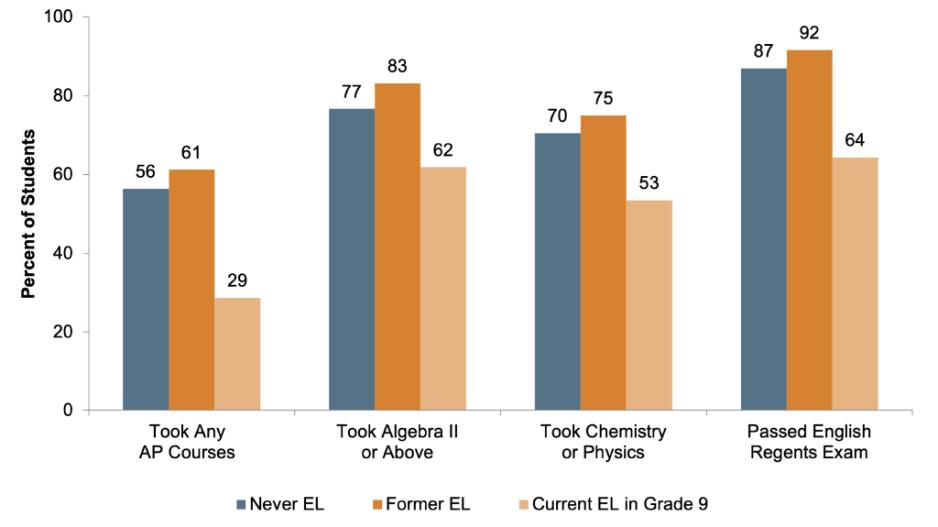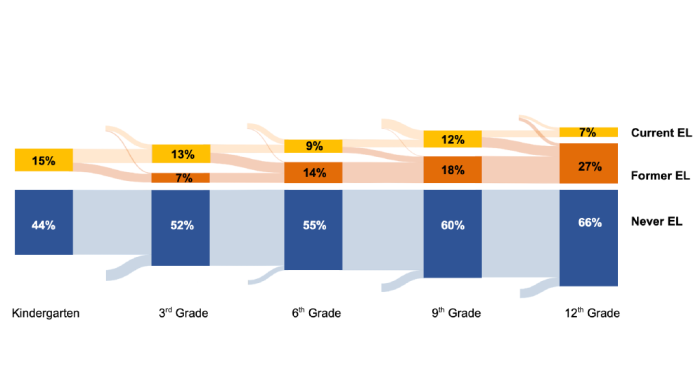The sixth post in our series exploring indicators of equity in NYC schools is authored by colleagues at the Center for the Success of English Learners and is funded by the Institute for Education Sciences.
In our previous post, we looked briefly at the timeline on which English learners in New York City enter the school system and when they become proficient in English. We argued that in order to understand how well the system is serving ELs as a whole, it is important to examine the outcomes of former English learners, in addition to those who are still receiving language service at any given time.[i]
To that end, this post considers several indicators of access and opportunity for students who began 9th grade for the first time in 2013, 2014, or 2015 (n = 191,236). We look at three different subgroups:
- Current English learners (Current ELs, n = 23,979): This group includes all students who were still receiving language services as of the 9th grade.
- Former English learners (Former ELs, n = 39,808): This group includes all students who received language services at any point between Kindergarten and 8th grade but who had been reclassified by 9th grade and were no longer considered to be English learners.
- Never English learners (Never ELs, n = 127,449): This group includes those who speak only English, as well as those who speak another language at home but who were proficient in English when they started school in New York City. This group of students never received language services, either prior to or during high school.
We also examine a set of longer-term outcomes for Never ELs (n = 127,449) in contrast with “Ever ELs” (n = 63,787), a group that combines current and former English learners. [ii] Examining indicators of students’ participation in rigorous coursework and their progress through high school and into college, we describe three main findings below.
Figure 1: Academic Participation and Outcomes by English Learner Subgroup

1. Students who are still English learners in high school lag behind in some important indicators of academic opportunity, particularly their participation in advanced coursework.
As Figure 1 indicates, Current ELs in high school participate in Advanced Placement courses at rates that are almost 30 percentage points lower than Never ELs. Only 62 percent take Algebra II, pre-calculus, or calculus before grade 12, while 77 percent of Never ELs do so. In advanced science, the participation gap is slightly larger, with 53 percent of Current ELs taking chemistry or physics, compared with 70 percent of Never ELs. Current ELs are also far less likely to pass the English Regents exam (64 percent vs. 87 percent of Never ELs).
It is important to note that students who used to be ELs but have become fully proficient in English by the time they enter high school have higher rates of participation in advanced coursework than Never ELs.[iii] As others have argued, this may be due to stronger academic and literacy skills in English that helped them pass the English proficiency test (which Never ELs do not take), in addition to expanded academic opportunities they may have once they are no longer English learners.
Figure 2: Progress Toward Graduation, by Grade and EL Subgroup

2. Although current English learners begin high school significantly behind Never ELs in indicators of academic progress, they narrow these gaps over time.
As Figure 2 shows, gaps between Current ELs and Never ELs tend to be largest at the beginning of high school. Only 34 percent of current English learners were on-track for graduation in grade 9, compared to 70 percent of Never ELs—a gap of more than 35 percentage points. Over time, however, Current ELs begin to catch up with their peers. By 11th grade, for instance, their on-track rate is only 25 percentage points behind Never ELs. After four years of high school, Current ELs’ graduation rate is 18 percentage points lower, and by six years out, the gap in graduation rates has shrunk to only 12 percentage points. These findings, which confirm what we have seen in other studies[iv], indicate that English learners may need additional time to meet academic requirements and successfully complete high school.
Figure 3: Academic Participation and Achievement, Among Never ELs and Ever ELs

3. In the long-term, students who were ever English learners have outcomes that are fairly similar to those of students who were never classified as ELs.
As a group, Ever ELs lag behind Never ELs only slightly—particularly in later educational outcomes. Ever ELs’ participation in advanced math and science coursework is 3-4 percentage points lower than that of Never ELs, and their graduation and college enrollment rates are each only 4 percentage points behind. Because Ever ELs are also more likely to live in high-poverty neighborhoods than Never ELs, these differences may reflect the influence of poverty or other related factors, rather than EL status, per se.
Conclusions
Together, Figures 1-3 indicate that improving outcomes of Ever ELs as a group will depend largely on improving the outcomes of those ELs who continue to receive language services in high school. Our findings also hint at the importance of helping Current ELs transition to 9th grade in ways that will set them up for long-term success. Finally, the analysis presented here demonstrates that ELs are in the midst of a years-long process to become fully proficient in English and that their outcomes at any given time may not be fully reflective of what they are capable of achieving in the long term. We owe it to them—as we owe it to all students—to represent that story as fully and faithfully as possible as we continue to examine equity in NYC schools.
Big Questions
- How should the system balance giving newcomer ELs enough time to develop their English proficiency while also ensuring they have access to rigorous coursework and can graduate from high school in a timely fashion? Are there some schools that are doing a particularly good job of striking this balance?
- How have the outcomes of current and former English learners in NYC changed over time, and, in particular, are there differences in how these groups fared during the COVID-19 pandemic?
- What practices will effectively support ELs in middle school and 9th grade, easing the transition into high school and helping ensure long-term success?
This post was authored by Kristin Black, Michael Kieffer and David Francis.
Endnotes
[i] Hopkins, M., Thompson, K. D., Linquanti, R., Hakuta, K., & August, D. (2013). Fully accounting for English learner performance: A key issue in ESSA reauthorization. Educational Researcher, 42(2), 101-108.
Kieffer, M. J., & Thompson, K. D. (2018). Hidden Progress of Multilingual Students on NAEP. Educational Researcher, 47(6), 391–398. https://doi.org/10.3102/0013189X18777740
Thompson, K. D., Umansky, I. M., & Rew, W. J. (2022). Improving Understanding of English Learner Education Through an Expanded Analytic Framework. Educational Policy, 08959048221087214.
[ii] New York State uses alternative definitions for both Former EL and Ever EL. See the NYSED website for further details. Our use of both terms aligns with how they are used in the broader research community.
[iii] For further reading on this phenomenon in NY State and California, respectively, see:
New York State Education Department (2019). New York State Multilingual Learner/English Language Learners (MLL/ELL) Data Report. Retrieved on Feb 2, 2023 from: http://www.nysed.gov/common/nysed/files/programs/bilingual-ed/nysed_ell_mll_data-report_2018-2019-a.pdf.
Stavely, Zaidee. (2023). Bilingual students do better on tests than native English speakers. Why? Retrieved on Feb 2, 2023 from: https://edsource.org/2023/bilingual-students-do-better-on-tests-than-native-english-speakers-why/
[iv] Kieffer, M. J. (2011). Converging trajectories: Reading growth in language minority learners and their classmates, kindergarten to grade 8. American Educational Research Journal, 48(5), 1187-1225.
Figure Notes
Author calculations based on data obtained from the NYC Department of Education. Sample includes students who were enrolled in 9th grade for the first time in the 2013-2014, 2014-2015, and 2015-2016 academic years (n =191,236). Subgroup sizes are as follows: Never ELs: 127,449; Ever ELs: 63,787; Former ELs: 39,808; Current ELs: 23,979. Sample excludes students enrolled in charter schools and Districts 75, 79, and 88 in Grade 9.
Definitions for selected outcomes in these figures are provided below:
- On-Track in 9th Grade: Accumulated at least 10 credits and passed at least 1 Regents exam by the end of Grade 9.
- On-Track in 11th Grade: Accumulated at least 32 credits and passed at least 3 Regents exams by the end of Grade 11.
- Took Algebra II or Above: Took any Algebra II/Trigonometry, Pre-Calculus, or Calculus by the end of expected Grade 12.
- Took Chemistry or Physics: Took any Chemistry or Physics by the end of expected Grade 12.
- Passed English Regents Exam: Received a 65 or higher on the English Regents exam by the end of expected Grade 12.
- Enrolled in College: Enrolled in a 2- or 4-year college in the fall immediately following expected 4-year graduation.
Suggested Citation
Black, K.E., Kieffer, M.J., & Francis, D.J. (2023). “What do we know about equitable access for English learners in New York City?” Spotlight on NYC Schools. The Research Alliance for New York City Schools.
The research reported here was supported by the Institute of Education Sciences, U.S. Department of Education, through Grant R305C200016 to the University of Houston. The opinions expressed are those of the authors and do not represent views of the Institute or the U.S. Department of Education.


